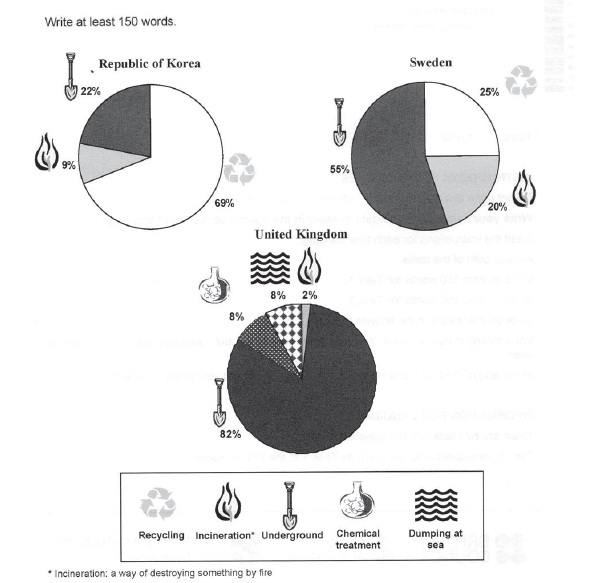The three pie charts provide information regarding how three countries overcome the danger of their waste products.
Clearly, the harm of waste products can be dealt with through five ways, they are recycling, incineration, keeping it underground, giving chemical treatment, or dumping it to the sea.
While the government of Republic of Korea recycles 69% of its rubbish and Sweden council does the same thing for a quarter of its, UK government does not at all. United Kingdom chooses to bury 82% of its waste products, 27% bigger than that of in Sweden, while only 22% of rubbish in Republic of Korea is solved by the same thing. The largest scale of burning rubbish is conducted in Sweden where 20% of its rubbish is solved by incineration, while Korean and British do the same way for 9% and 2% respectively for theirs.
Interestingly, while Korean and Swedish apply only 3 methods of reducing the danger of waste products, British uses 5 methods. It dumps 8 % of its rubbish at sea and the same amount is given chemical treatment.
Clearly, the harm of waste products can be dealt with through five ways, they are recycling, incineration, keeping it underground, giving chemical treatment, or dumping it to the sea.
While the government of Republic of Korea recycles 69% of its rubbish and Sweden council does the same thing for a quarter of its, UK government does not at all. United Kingdom chooses to bury 82% of its waste products, 27% bigger than that of in Sweden, while only 22% of rubbish in Republic of Korea is solved by the same thing. The largest scale of burning rubbish is conducted in Sweden where 20% of its rubbish is solved by incineration, while Korean and British do the same way for 9% and 2% respectively for theirs.
Interestingly, while Korean and Swedish apply only 3 methods of reducing the danger of waste products, British uses 5 methods. It dumps 8 % of its rubbish at sea and the same amount is given chemical treatment.

jj.jpg
